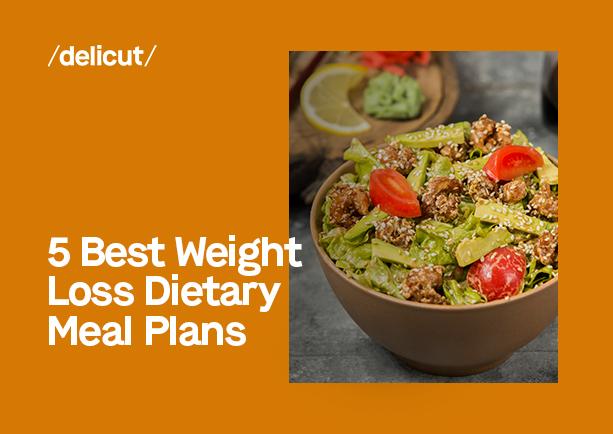5 Best Weight Loss Dietary Meal Plans

While exercise is important, it's the dietary choices we make that can significantly accelerate the process of shedding unwanted pounds. Recognizing this, dietary meal plans have emerged as an effective tool for those looking to lose weight in a healthy and sustainable manner. These plans simplify the daily decision-making process regarding food and ensure a balanced intake of essential nutrients.
In this blog, we delve into five of the best dietary meal plans for weight loss. Each plan offers a unique approach to nutrition, catering to various preferences and lifestyles.
The Mediterranean Diet Plan
The Mediterranean Diet is renowned for its combination of delicious flavors and numerous health benefits, particularly in weight loss and heart health. Central to this diet are whole, unprocessed foods typical in Mediterranean cuisine, such as fruits, vegetables, whole grains, nuts, seeds, and olive oil.
Lean sources of protein, like fish and poultry, are emphasized, while red meat and sweets are enjoyed in moderation.
This dietary meal plan emphasizes high-fiber foods, which help in feeling full and satisfied, thus reducing overall calorie intake. Including healthy fats, primarily from olive oil and fish, not only aids in satiety but also benefits heart health.
Typical meals in this diet plan might include grilled fish or chicken with a variety of seasoned vegetables, whole grain pasta dishes adorned with fresh herbs and olive oil, and an abundance of fresh fruits for dessert or snacks.
1. The Plant-Based Diet Plan
The Plant-Based Diet is a wholesome approach to weight loss that focuses on consuming foods primarily from plant sources. This diet is rich in vegetables, fruits, whole grains, legumes, nuts, and seeds while minimizing or excluding animal products.
One of the main advantages of this dietary meal plan for weight loss is its high fiber content. Foods like beans, lentils, whole grains, and a variety of fruits and vegetables are filling and low in calories, which can help create a calorie deficit necessary for weight loss.
Additionally, these foods are rich in essential nutrients, antioxidants, and phytochemicals that support overall health.
Meals range from hearty vegetable stews and legume-based curries to whole grain salads and fruit smoothies. This diet encourages creativity in the kitchen, allowing individuals to explore various flavors and cuisines while focusing on nutrient-dense, low-calorie foods.
2. The Low-Carb, High-Protein Diet Plan
The Low-Carb, High-Protein Diet is a popular approach for those targeting weight loss, especially for individuals looking to enhance muscle tone while shedding fat. This diet plan reduces carbohydrate intake and focuses on higher protein sources, which can lead to a decrease in appetite and an increased metabolic rate.
Protein-rich foods such as lean meats, fish, eggs, dairy products, and legumes are staples in this diet. They provide the necessary amino acids for muscle repair and growth, crucial for those engaged in regular physical activity.
By limiting carbohydrates, especially refined sugars and grains, this diet aims to reduce insulin spikes and encourage the body to use stored fat as a primary energy source.
This dietary meal plan includes meals in a low-carb, high-protein diet, which might include grilled chicken or fish with a side of leafy greens, egg-based dishes like omelets filled with vegetables and cheese, or protein-rich smoothies. Snacks often consist of nuts, seeds, or Greek yogurt.
2. The Paleo Diet Plan
The Paleo Diet, often termed the 'Caveman Diet,' is structured around the concept of eating like our pre-agricultural, hunter-gatherer ancestors. This diet includes foods that could be obtained through hunting and gathering, emphasizing lean meats, fish, fruits, vegetables, nuts, and seeds.
It excludes processed foods, grains, legumes, and dairy, which are believed to be products of modern agriculture and farming.
Adopting this dietary meal plan can lead to weight loss as it naturally reduces your intake of processed foods and emphasizes whole, nutrient-dense foods. By eliminating grains and processed sugars, the diet aims to reduce blood sugar spikes and promote a more stable energy level throughout the day.
A typical day on the Paleo Diet might involve starting with a breakfast of scrambled eggs with spinach and mushrooms, a lunch of grilled chicken salad with a variety of vegetables, and a dinner featuring a lean steak with a side of roasted vegetables. Snacks could include a handful of nuts or fresh fruit.
3. Intermittent Fasting Meal Plan
Intermittent Fasting (IF) is a unique eating approach that cycles between fasting and eating. It doesn't prescribe specific foods but rather focuses on when you should eat them.
Common IF methods include the 16/8 method, where you fast for 16 hours and eat during an 8-hour window, and the 5:2 method, which involves eating normally for 5 days and reducing calorie intake for 2 non-consecutive days per week.
The effectiveness of this dietary meal plan in weight loss is linked to its ability to reduce overall calorie intake and optimize hormone levels that facilitate weight loss. During fasting periods, lower insulin levels and increased growth hormone levels enhance fat-burning and muscle growth.
Meals should include a mix of lean protein, healthy fats, and fiber-rich carbohydrates. For instance, breaking the fast with a meal of grilled salmon, quinoa, and vegetables, followed by snacks like fruits and nuts, and concluding with a protein-rich chicken and vegetable stir-fry can maximize the benefits of IF.
Conclusion
A weight loss journey is a deeply personal experience, and choosing the right dietary meal plan is a key component of success. It is crucial to remember that the best diet is one that not only aids in weight loss but also aligns with your lifestyle, preferences, and overall health goals.
Combining these dietary meal plans with regular physical activity and mindful eating habits will further enhance your journey toward a healthier, fitter you. Choose your path wisely, and let your weight loss diet be your ally in achieving your aspirations.
FAQs
1. What are the 5 foods to help you lose weight?
- Five effective foods for weight loss include:
- Leafy Greens: Low in calories but high in fiber, they help keep you full.
- Whole Grains: Like quinoa and oats, they provide sustained energy and reduce hunger.
- Lean Protein: Chicken breast, fish, and legumes keep you satiated and aid muscle repair.
- Berries: Rich in antioxidants and fiber, they're a sweet treat that's low in calories.
- Greek Yogurt: A good source of protein and probiotics, it supports digestion and weight management.
2. What is the best diet to eat every day to lose weight?
A balanced diet rich in whole foods is best for everyday weight loss. This includes a variety of fruits and vegetables, whole grains, lean proteins, and healthy fats. Portion control, reduced intake of processed foods and sugars, and regular, balanced meals help in sustainable weight loss.
3. What is the most effective meal schedule for weight loss?
An effective meal schedule for weight loss typically includes 3-5 meals spaced throughout the day. This can be three main meals and one or two snacks. Eating at regular intervals helps to regulate blood sugar levels, reduce overeating, and maintain steady energy levels. It's also beneficial to have a light, early dinner and avoid eating late at night.
4. What are some good diet meals to lose weight?
- Good diet meals for weight loss could include:
- A breakfast of oatmeal with berries and nuts.
- A lunch of grilled chicken salad with a variety of vegetables.
- A dinner of baked fish with quinoa and steamed broccoli.
- Snacks such as Greek yogurt, a piece of fruit, or raw vegetables with hummus.
5. What are 20 foods that burn fat?
Avocado, berries, and green tea support fullness and provide antioxidants, while coffee and chili peppers may enhance metabolism. Whole eggs, Greek yogurt, and fatty fish offer protein and healthy fats. Apple cider vinegar, nuts, seeds, and coconut oil bring diverse flavors with potential fat-burning benefits. Incorporate legumes, whole grains, citrus fruits, tofu, and broccoli for variety and nutrition. Turmeric adds anti-inflammatory properties.
Read More:
The Benefits of Including Superfoods in Your Diet
Healthy Food Swaps: Small Changes for Big Health Benefits
Exploring Plant-Based Protein Foods for a Healthier Diet
The Power of Mindful Eating: How to Develop a Healthy Relationship with Food
The Link Between Diet and Mental Health: Foods for a Happy Mind
Related Blogs
Why do most people in the UAE get their calories wrong
Dec 8, 2025 | 6DASH Diet Meal Plan
Nov 11, 2025 | 8Fatty Liver Meal Plan
Oct 31, 2025 | 8Pregnancy Diet Meal Plan
Oct 27, 2025 | 82000 Calorie Meal Plan
Oct 1, 2025 | 8Intermittent Fasting Diet Plan
Sep 5, 2025 | 81000 Calorie Meal Plan
Sep 5, 2025 | 8High-Protein Meal Plans
Sep 5, 2025 | 8How to Choose the Right Meal Plan for Your Fitness Goals
Sep 5, 2025 | 8The GM diet plan: Is it possible to shed fat in just 7 days?
Sep 5, 2025 | 8






